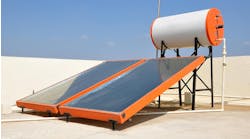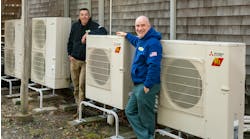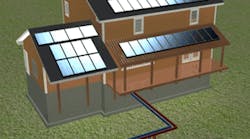Latest from Solar
IAPMO Seeks USHGC Task Group Members
Heat Pumps Get Us to Net Zero
Sponsored
BATHURST, NEW BRUNSWICK, CANADA — The downturn in the U.S. housing market, coupled with rising energy costs, is forcing American homeowners to re-evaluate the way their homes are heated and cooled.
According to the U.S. Department of Energy, 21% of the country’s total energy consumption takes place at home with space heating and cooling expected to see the largest increases over the next 40 years. Combined with total global energy consumption to double by 2050, the need for cost effective solutions is more critical than ever.
Geothermal, the use of energy beneath the Earth’s surface, has been widely accepted in Europe where sustained high energy costs meant homeowners were more open to adopt alternative solutions. While geothermal has a modest presence already in the U.S., its usage has been primarily in areas with a heightened environmental awareness.
Widespread adoption, however, has yet to take hold for a variety of reasons — mainly cost of installation and availability.
Good geothermal products and professional contractor training are but two components for success.
EcoPlusHome
What if there was a house that emitted zero emissions and while offering the same heating/cooling comfort as current residences but at a fraction of the cost? The structure would sustain itself and not require any natural resources for its day-to-day operations. Harnessing the power of the sun, earth and wind, the home could operate more efficiently while dramatically reducing dependence on non-renewable natural resources.
Situated in Bathurst, New Brunswick, Canada, the Bosch Thermotechnology EcoPlusHome (EPH) project has brought together the brightest minds and latest advancements in sustainable home technology to answer whether a home could not only achieve net-zero status, but also retain a reasonable price point of $250,000 for the U.S. consumer — a dilemma which has been a major roadblock for widespread net-zero adoption.
In addition, the house couldn’t be a mere showcase piece — Bosch wanted to design a home HVAC configuration that could easily be replicated for mass installation in both new construction and retrofits coast-to-coast. With EcoPlusHome constructing efficient homes at an affordable price across Canada already, a partnership was formed.
To move past theory, members of the EPH team needed a concept that would solve three key issues currently holding back most homeowners from making the net-zero transition: associated costs; ease of design and installation versus traditional solutions; availability of net-zero homes and/or products
The 3,067-sq.ft. home was delivered to the building site in four pre-fabricated sections where crews assembled the residence. To test the home versus the above criteria, the Kenny family — father Brian, mother Renee and their kids Tyler, 14, Grayson, 12, Shane, 8 and Olivia, 6 — lived in the home between December 2009 and December 2010. The date range would give the family ample time to adapt to the new technologies inside while using them during a variety of weather conditions (temperatures in Atlantic Canada range from -25°F to 95°F). The end goal was to show that a typical modern family could not only sever its dependency on non-renewable fuels, but actually save money over the life of the home.
“By providing a highly efficient geothermal heat pump, solar thermal system, photovoltaic panels and energy-efficient home appliances for EcoPlusHome, we have demonstrated that climate protection pays off and that net-zero living can be achieved comfortably and affordably,” said Peter Marks, chairman, president and CEO, Robert Bosch LLC and member of the Bosch Board of Management. “As a leading technology company, Bosch is committed to supplying innovative solutions that help conserve resources and protect the environment.”
With a year to study the home’s performance, the team had the opportunity to not only track consumption, but also study how the suite of sustainable home comfort solutions performed under different variables. In addition, testing for one year enabled an overall stronger design of the system and helped optimization for later installations in future EcoPlusHome models (e.g. cost reduction, faster, higher quality of design). Geothermal serves as the central power source for the home’s heating and cooling needs. The home required a vertical loop configuration, which required drilling into the Earth’s surface several hundred feet.
The net-zero system components were sized to generate as much electricity as is being consumed in one year.
During peak demand energy is drawn from the grid, and during peak generation energy is fed back into the grid. In addition, zero dependence on fuel makes the home immune to fluctuating fuel prices that spike during peak demand seasons. This allows a more accurate forecast for homeowners each month when it comes to budget planning, a welcomed constant in today’s economic conditions.
Had the home been constructed on U.S. soil, a 30% tax credit towards the installation cost would’ve been available for a substantial reduction in the unit’s overall installation as well.
Savings and benefits
While the full suite of sustainable products was impressive, the EcoPlusHome would be deemed a failure if significant energy savings were not realized. Compiling data from the previous 12 months, EcoPlusHome plus team members were stunned by the results. In fact, the EPH generated more electricity than it used, satisfying the traditional definition of an energy plus home. In one year, the homeowners of the EcoPlusHome consumed 14,234 kWh; at the same time the home generated 15,199 kWh, resulting in a surplus of 965 kWh.
With reduced reliance on fossil fuels, the EPH home produces few emissions and helps promote a healthy living space and cleaner air. The overall reduced dependence on fossil fuel makes an EcoPlusHome immune to fluctuating fuel prices that can increase during peak demand seasons, allowing a more accurate forecast for the homeowner’s budget.
Related Articles:
Near-zero Lab Home paves way to eradicating energy bills
Related Articles:
Kennedy green house is living laboratory


